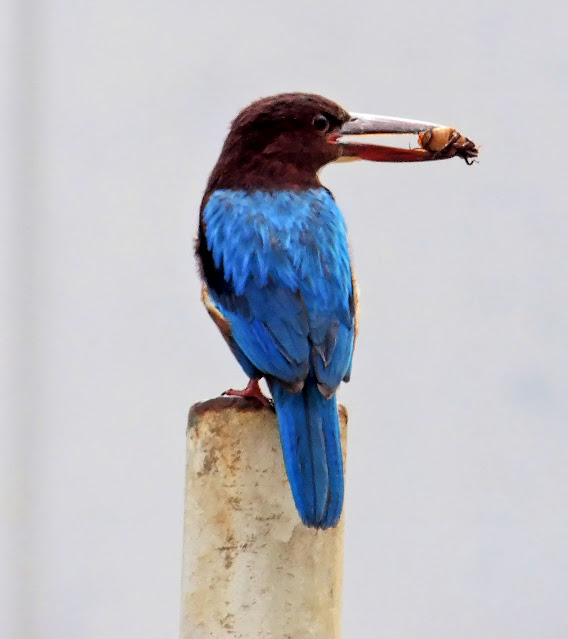The Grey heron (Ardea cinerea) is a large long-legged wading bird of the heron native to Europe and Asia and also parts of Africa. It lives in wetland areas and feeds on various aquatic creatures which it catches after standing stationary beside or in the water.
The plumage of the Grey heron is largely ashy-grey above, and greyish-white below with some black on the flanks. Adults have a head and neck white with a broad black supercilium that terminates in the slender, dangling crest, and bluish-black streaks on the front of the neck. The scapular feathers are elongated and the feathers at the base of the neck are also somewhat elongated. Immature birds lack the dark stripe on the head and are generally duller in appearance than adults, with a grey head and neck, and a small, dark grey crest. The pinkish-yellow beak is long, straight, and powerful, and is brighter in color in breeding adults. The iris is yellow and the legs are brown and very long.

Grey herons occur in most parts of Europe, Asia, and Africa. Over much of their range, these birds are resident, but populations from the more northerly parts of Europe migrate southwards; some remain in Central and Southern Europe, and others travel on to Africa south of the Sahara Desert. Grey herons can be found anywhere with suitable watery habitats that can supply their food. Although most common in the lowlands, they also occur in mountain tarns, lakes, reservoirs, large and small rivers, marshes, ponds, ditches, flooded areas, coastal lagoons, estuaries, and seashore. They sometimes forage away from water in the pasture, and can even be found in desert areas, hunting for beetles and lizards.

The plumage of the Grey heron is largely ashy-grey above, and greyish-white below with some black on the flanks. Adults have a head and neck white with a broad black supercilium that terminates in the slender, dangling crest, and bluish-black streaks on the front of the neck. The scapular feathers are elongated and the feathers at the base of the neck are also somewhat elongated. Immature birds lack the dark stripe on the head and are generally duller in appearance than adults, with a grey head and neck, and a small, dark grey crest. The pinkish-yellow beak is long, straight, and powerful, and is brighter in color in breeding adults. The iris is yellow and the legs are brown and very long.
Grey herons are the largest birds most of us ever see in our garden: the wing span is around 6ft.

Despite their size, they are surprisingly light, weighing on average only half as much as a greylag goose.
The old English name for a heron was hragra; other names now largely fallen into disuse include harn, hernser and hernshaw. Heron comes from the French, for the French name is héron céndre.
In medieval times the heron was a favourite quarry of falconers who valued its great flying skills and ability to evade the falcon's stoops.
Roast herons were also popular at medieval banquets: the young birds, called branchers, were thought to be the best to eat.
The fat of a heron killed at full moon was once believed to be a cure for rheumatism.
Herons are sociable birds when nesting, invariably nesting in long-established heronries.
Most heronries are in trees, with the majority of nests at least 25m above the ground. However, reed-bed heronries are not unusual, and they will also nest on cliffs, bushes, sometimes even on buildings of bridges.
Heronries can reach a prodigious size: one at Great Snowden's Wood, near Brede in Sussex, contained around 400 nests in 1866.
The biggest heronry in Britain is currently at Northward Hill in Kent, an RSPB reserve. Numbers here have peaked at over 200 nests, but the current total is around 150.
It's not unusual for a single tree to hold as many as 10 nests.
It's quite normal for herons, disturbed at their nest, to regurgitate their last half-digested meal, an unpleasant experience for anyone unfortunate enough to be underneath the nest.
An increasing number of British heronries now also have little egrets nesting alongside the herons.
Herons are among the earliest nesters. It's not unusual for some birds to lay their first eggs in early February, though the normal start is early March, peaking at the end of the month.
The number of herons breeding in Britain and on the Continent has been growing steadily for many years.
They suffer badly in cold winters when ponds and streams are frozen for prolonged periods. The recent run of mild weathers has helped boost the population.
Grey herons are widely distributed, occurring throughout much of Asia as far east as Japan. They also breed in South Africa, while migrants are regular throughout much of Africa.
Only 3.3% of British-ringed herons have been recovered overseas, with the most distant recoveries in Morocco and the Gambia.
Persuading marauding herons not to raid goldfish ponds is very difficult. The only 100% effective protection is netting the pond.
Plastic decoy herons are more likely to lure birds to a pond than frighten them away from it.
%2020.jpg)
%2021.jpg)

%2020.jpg)

%2020.jpg)
%2021.jpg)
%2022.jpg)
%2023.jpg)





%2020.jpg)


%2020.jpg)
%2022.jpg)
%2023.jpg)











%2010.jpg)
%2011.jpg)

%20(Monticola%20solitarius)%2010.jpg)
%20(Copsychus%20saularis)%2020.jpg)










%2010.jpg)